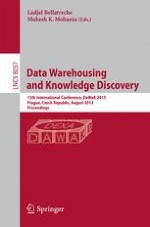This book constitutes the refereed proceedings of the 15th International Conference on Data Warehousing and Knowledge Discovery, DaWaK 2013 held in Prague, Czech Republic, in August 2013.
The 24 revised full papers and 8 short papers presented were carefully reviewed and selected from 89 submissions. The papers are organized in topical sections on modeling and ETL, query optimization and parallelism, spatial data warehouses and applications, text mining and OLAP, recommendation and prediction, data mining optimization and machine learning techniques, mining and processing data streams, clustering and data mining applications, social network and graph mining, and event sequence and Web mining.
